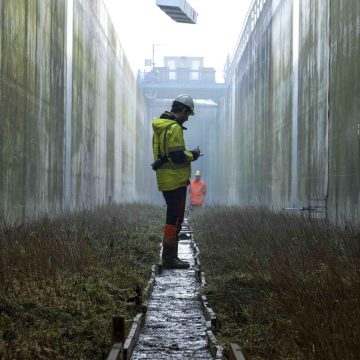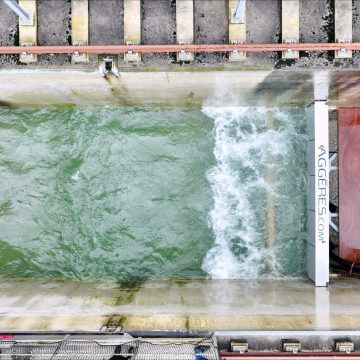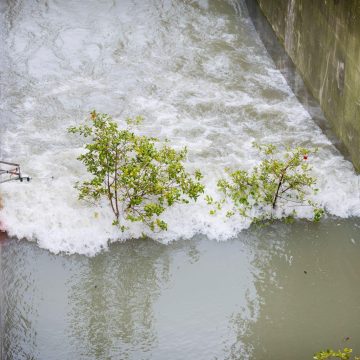Deltares Delta Flume
The Deltares Delta Flume is a unique test facility where on real scale (1:1) the effect of extreme waves on dikes, dunes, breakwaters, and other flood defences can be tested. There is considerable global demand for the realistic testing of hydraulic structures in particular situations. This flume is a versatile, indispensable facility that can be used for numerous projects: coastal, harbour and offshore structures.
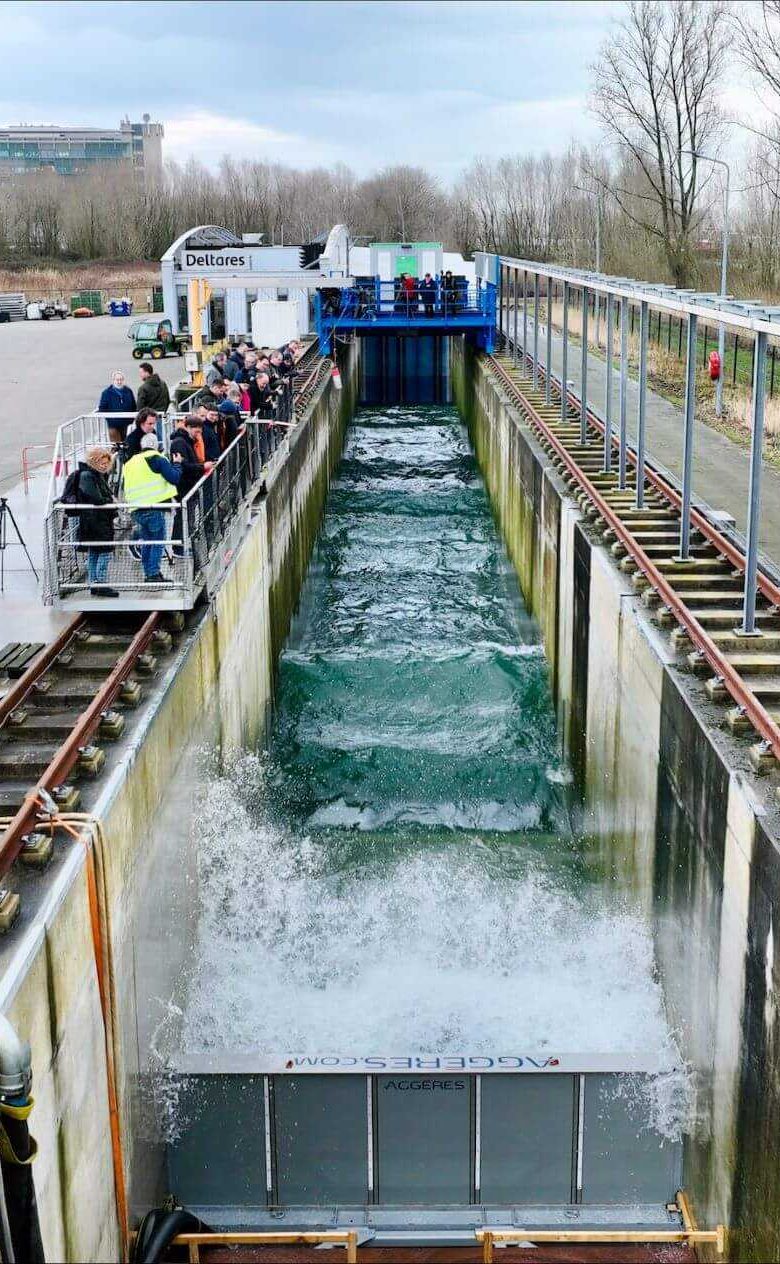
The Deltares Delta Flume allows Deltares to carry out research for national and international clients, and public and private bodies. Our leading clients include the Dutch Ministry of Transport and Public Works (Rijkswaterstaat), the EU, contractors, energy utilities, developers of renewable energy concepts and e.g. concrete factories.
It can be used for studies in which major factors affecting the results include not only large water movements but also the detailed flows in small spaces between stones and sand or clay. It is not easy to establish a clear picture of how these things work at small scales. These types of tests can be conducted at full scale in this flume. Typical measurements in the Deltares Delta Flume will look at wave heights, wave pressures and forces, flow velocities, wave overtopping, damage patterns and changes in cross-sections.
Full-scale tests in the Deltares Delta Flume
More than ever climate change puts a high pressure on water defenses. Every year around 7000 persons die worldwide as consequence of flooding (source: UNESCO). The economic damage is currently 22 billion Euro per year and will only increase if no countermeasures are taken. To ensure flood protection – against affordable costs – new innovative measures are needed. For example, alongside ‘hard’ barriers, ‘soft’ measures that use natural processes can also provide solutions.
Currently many of these innovative solutions are suffering from a lack of knowledge regarding their behaviour under natural (storm) conditions. Tests at real scale under controllable conditions contribute to evidence-based answers. In the Delta Flume, many flood defenses, including nearly all Dutch sea defenses can be exposed to design storm conditions at real scale, even those with a frequency of occurrence of 1 over 10000 years.
Video: opening wave Deltares Delta Flume
You have not yet indicated whether you want to accept or reject cookies. This means that this element cannot be displayed.
Or go directly to:
Largest waves in the world
Construction work on the new Delta Flume began in September 2012, with Ballast Nedam Infrastructure as the contractor. The Delta Flume is 300 m long, between 7 and 9.5 m deep and 5 m wide.
The length of the facility is necessary to simulate the wave propagation over gradually rising foreshores, such as coast profiles and floodplains. The modelling area with a depth of 9.5 m and a length of 183 m, with an extra 75 m section of 7 m deep. The remaining part of the flume length is for the wave generator.
The deep part has a length that is sufficient to model structures such as embankments while the combination with a shallower section allows for modelling of gentle foreshores over a length of about 250 m in combination with for instance dunes. Typically employed water depths at the wave board are between 2.5 m and 8 m.
The depth is required to generate individual waves up to 4.5 m height (Hs = 2,0 m - 2,05 m). Such large waves cannot be generated anywhere in the world so far. To generate these large waves, a 10 m high wave paddle is used, which is translated horizontally with hydraulic cylinders. The optimal water depth at the wave board for reaching the highest significant wave height for which also the wave height distribution is modelled accurately, is 6.5 to 6.9 m.
The wave board is equipped with the Active Reflection Compensation system (ARC) functionality, a control and feedback control system which absorbs waves reflected by the structure, which otherwise would disturb the measurements.
Four Olympic swimming pools
A water reservoir containing 9 million litres of fresh water is located alongside the Delta Flume. That is the equivalent of four Olympic swimming pools. The reservoir is situated underground parallel to the flume. There are three pumping stations with a combined capacity of 1.0 m3/s to pump the water between the reservoir and the flume. That can also be done during testing, allowing to simulate variations in the water level of the kind caused by storm surges and tides, during generating waves. That is important for studies of, for example, dike revetments.
Simulating sea state
The waves in the Delta Flume are generated with a horizontally translated (piston type) vertical wave board. In nature regular waves are rarely encountered, there is a continuous variation between large and small waves, the so-called sea state. The wave board can simulate this sea state by software-controlled motion of the wave board and a direct use of the wave measurements within the flume. This also allows the generation of random second order waves, focused waves, and Tsunami modeling.
Preventing and diminishing scale effects
One of the main advantages of the Delta Flume is that scale effects are minimised, because a large portion of the tests can be performed at (close to) prototype scale. Preventing or diminishing scale effects is for instance important for coastal structures in which sand, clay, grass, or other natural construction material is being applied. Dikes, dunes, breakwaters, bed protections, offshore wind farms and storm surge barriers can be tested.
Measurements and measurement techniques
Typical measurements which can be performed in the Delta Flume are wave height measurements, pressures, (wave) forces, current velocities, wave overtopping and damage profiles. Various measurement techniques are developed to extract data from the experiments in the flume. Besides classic point measurements, also synoptic measurement techniques (i.e. high-resolution measurements of time varying spatial fields) have been developed.
For the measurements of waves (at the wall) the proven resistance type wave probes are used. Radars can be used to obtain wave height measurements at any location. In addition, the use of laser scanners and stereo matching of video images can be used to obtain spatially distributed information of waves and/or (deformed) structures. Also, good visual observation of the tests is ensured using for instance a central video observation system and many (flush) cavities in the wall near the location of most models to install instruments.
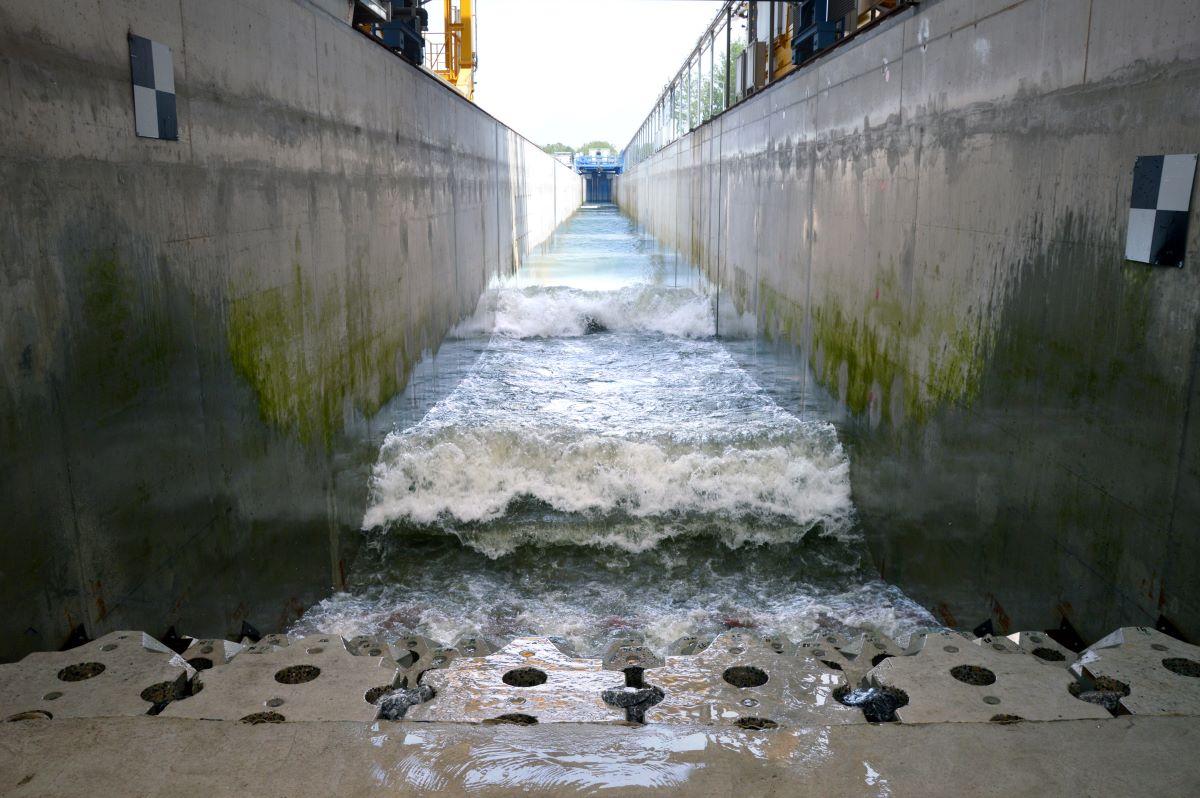
Delta Flume projects
Designs for flood defences, dunes or breakwaters can be tested in the Delta Flume so that clients can ultimately select the best, most cost-efficient, and future-robust solution. Also, the Delta Flume is very equipped for testing of wave loads on offshore structures such as wind turbines, oil platforms and the protection of cables and pipelines.
The size and available wave conditions of the Delta Flume make it possible to test almost every structure on a near to prototype scale. A few examples are:
- Breakwaters (stability of armour layers, wave overtopping, wave pressures, wave forces)
- Embankments / Dikes (wave overtopping, wave runup, stability of inner and outer slopes, wave forces)
- Erosion of vegetated foreshores, including wave damping due to vegetation (such as saltmarsh, grass, or shrubbery)
- Placed block revetments
- Dune erosion
- Scour and stability of bed protections
- Offshore pipelines and structures
- Testing of Wave Energy Converters (WEC’s)
- Wave load on floating structures
- Testing underwater vehicles in combination with turbulent conditions
- Testing and calibrating field equipment
Technical specifications
Wave flume
- Overall length approximately 291m
- Width: 5 m
- Depth: 9.5 m
Wave generator
- Full stroke: 7 m
- “Dry-back”, piston-type wave board drive (cradle, 4 pistons)
- Second-order wave steering system
- Active Reflection Compensation
- Installed electric power for wave generation: 1.9 MW
Wave machine design and supplier MTS (USA)
- Wave characteristics
- Maximum height (regular) H max,r: 3.3 m
- Maximum wave height H = 4.5 m
- Maximum significant wave height H m0: 2.0 m
- Wave peak period (H m0 = 2.0 m): 5.7 s < Tp < 13.4 s
- Wave period 1 s < T < 20 s.
Details
- Reservoir (length, width, depth equal to flume dimensions).
- Pumps between flume and reservoir to simulate tides or wind surge and to fill or empty different parts of the flume. Measurement cavity (width 9 m, depth 10 m, length 1.5 m).
- Flume gantry crane (2 pulley arrays, 125 kN each).
- Pull/measurement trolley (maximum speed 1 m/s and pulling power of 10 kN).

